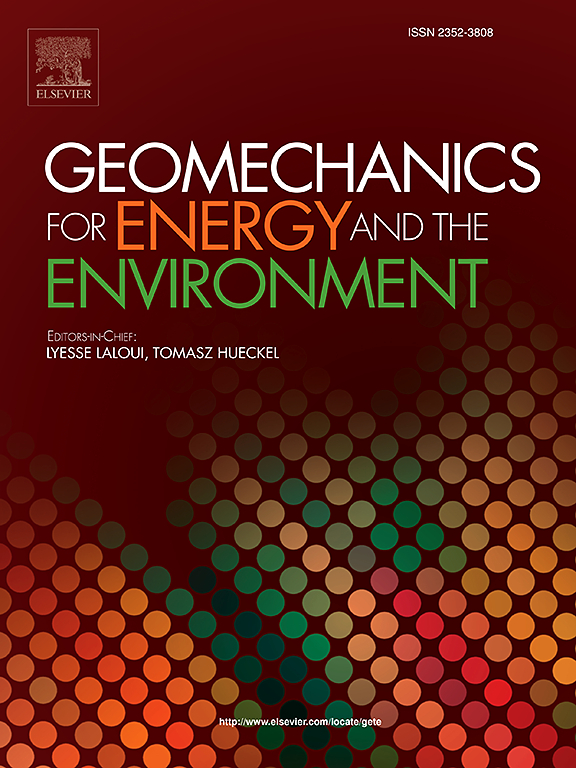使用带保温管环路的新型外部水力加热系统进行地热桥面除冰
IF 3.3
2区 工程技术
Q3 ENERGY & FUELS
引用次数: 0
摘要
以地热为基础的外部水力加热系统(EHHS)是解决在役桥梁除冰需求的有效解决方案,对结构、交通和环境的负面影响最小。本文讨论了 EHHS 新设计的实施和运行反应,在该设计中,仅在水力加热环路上覆盖隔热材料,而不是整个桥面的底面,并为桥面的可视检查提供了便利。第一个带隔热环路的全尺寸外部水力加热系统(EHHS-IL)安装在德克萨斯州北部的一个模拟桥面上,并在创纪录的暴风雪中进行了测试,环境温度低至零下 19.5 ˚C。系统分三个不同阶段运行,入口流体温度根据天气预报进行调整。总体而言,在为期 10 天的运行期间,共观测到三次冰雪天气和 209 小时的冰冻环境温度。除 1.3 小时内因降雪而出现-19.5 ˚C的低环境温度外,加热系统能够将加热后的桥面表面温度保持在冰点以上。测试期间的平均表面热通量在 34.8 - 84 W/m2 之间变化,平均加热效率估计为 17.7%。在供暖期间,系统的季节性能系数(SPF)始终大于 1。此外,整个地热除冰系统在 10 天的运行期间消耗了 422 千瓦时的电能。这种新型地热桥梁除冰系统通过改造为结冰桥梁提供了一种实用的解决方案。本文章由计算机程序翻译,如有差异,请以英文原文为准。
Geothermal bridge deck de-icing using a novel external hydronic heating system with insulated pipe loops
A geothermal-based external hydronic heating system (EHHS) has been developed as an effective solution to address the de-icing needs of in-service bridges with minimum negative impacts on the structure, traffic, and environment. This paper discusses the implementation and operational response of a new design of the EHHS in which rather than the whole bottom surface of the bridge deck, only the hydronic heating loops are covered with insulation material and provides the accessibility for visual inspection of the bridge deck. The first full-scale external hydronic heating system with an insulated loop (EHHS-IL) was installed on a mock-up bridge deck in north Texas and tested in a record snowstorm with a low ambient temperature of −19.5 ˚C. The system operated in three different stages, and the inlet fluid temperature was adjusted according to the weather forecast. Overall, during a 10-day operation, three ice and snow events and 209 hours of freezing ambient temperature were observed. The heating system was able to maintain the heated bridge deck surface temperature above freezing except for 1.3 hours when the −19.5 ˚C low ambient temperature coincided with snowfall. The average surface heat flux during the test varied from 34.8 – 84 W/m2, and the average heating efficiency was estimated at 17.7 %. The seasonal performance factor (SPF) of the system remains consistently greater than 1 during the heating period. Also, 422 kWh of electrical energy was consumed during 10 days of operation by the entire geothermal de-icing system. This new geothermal bridge deicing system offers a practical solution to icy bridges by retrofitting.
求助全文
通过发布文献求助,成功后即可免费获取论文全文。
去求助
来源期刊

Geomechanics for Energy and the Environment
Earth and Planetary Sciences-Geotechnical Engineering and Engineering Geology
CiteScore
5.90
自引率
11.80%
发文量
87
期刊介绍:
The aim of the Journal is to publish research results of the highest quality and of lasting importance on the subject of geomechanics, with the focus on applications to geological energy production and storage, and the interaction of soils and rocks with the natural and engineered environment. Special attention is given to concepts and developments of new energy geotechnologies that comprise intrinsic mechanisms protecting the environment against a potential engineering induced damage, hence warranting sustainable usage of energy resources.
The scope of the journal is broad, including fundamental concepts in geomechanics and mechanics of porous media, the experiments and analysis of novel phenomena and applications. Of special interest are issues resulting from coupling of particular physics, chemistry and biology of external forcings, as well as of pore fluid/gas and minerals to the solid mechanics of the medium skeleton and pore fluid mechanics. The multi-scale and inter-scale interactions between the phenomena and the behavior representations are also of particular interest. Contributions to general theoretical approach to these issues, but of potential reference to geomechanics in its context of energy and the environment are also most welcome.
 求助内容:
求助内容: 应助结果提醒方式:
应助结果提醒方式:


